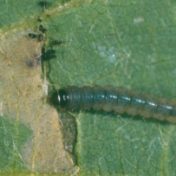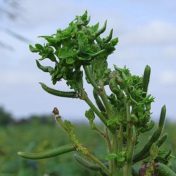Megoura crassicauda has been found in parts of north-east and central New South Wales (Sydney, Tamworth, and Breeza). The species originated in north-east Asia, and is closely related to the vetch aphid (Megoura viciae), found in Europe, Ethiopia and North America. Its host range is mostly limited to Vicia species – vetches, faba or broad beans, and may extend to… Read more »
Helicoverpa are the primary insect pest of chickpeas. Beneficial insects that are present in many crops do not thrive in chickpeas, so successful helicoverpa management relies heavily on monitoring and identification, appropriately timing control to crop stage, and using the recommended thresholds. Monitoring involves regular in-field checking with a beat sheet. Additionally, moth numbers can be monitored using pheromone traps… Read more »
Russian wheat aphid (RWA) is considered a high priority pest by the grains industry because of its potential to cause significant yield losses in wheat and barley if not well managed. Triticale and rye are also susceptible to crop loss, but oats are considered relatively tolerant. It is inevitable that RWA will establish in the northern grains region, but we… Read more »
Of importance to agronomists is how pest populations are changing over time and the likely impact predators will have on the pest population. Predator and parasitoid activity can be difficult to assess under field conditions, particularly the rate at which beneficials can find pest species. In this research, sentinel prey were used to gauge the level of natural predator and… Read more »
The tiny wasp Eretmocerus hayati is an important natural enemy of silverleaf whitefly (SLW) and contributes to the natural biological control of this pest throughout the season. It occurs in almost all regions that grow cotton, but due to its small size (difficult to see without a hand lens) it often goes unnoticed. Like all natural enemies, Eretmocerus is susceptible… Read more »
Winter—time to visit your storages As temperatures drop and hopefully winter crop planting is completed, a little time invested around your storage facility will pay dividends. During our coldest months storage pests are not breeding rapidly and are less likely to fly. They are quietly sitting in grain residues in empty silos, or keeping warm in silos still holding grain…. Read more »
This summer silverleaf whitefly (SLW) populations have been extremely high in many cotton crops, particularly in NSW. As these crops are defoliated, large numbers of SLW are moving out of the cotton into surrounding vegetation, including emerging grain crops. Whilst the number of SLW adults landing in seedling canola, wheat, faba beans and cereals can look dramatic, previous experience has… Read more »
The spread of Russian wheat aphid (RWA) (Diuraphis noxia) in the Northern grains region is considered inevitable. When it might be detected in wheat and barley is less clear as the key drivers of its spread are not well understood in Australia. Wind is likely to play a part in moving winged aphids from south to north. The most northerly… Read more »
Major soybean moth outbreaks have recently been reported in some coastal Burnett soybean crops, and lesser outbreaks in crops in the Burdekin. Soybean moth is generally a minor soybean pest but major outbreaks have been reported periodically in all soybean growing regions. In extreme cases, crops can be totally defoliated. Feeding damage Larvae feed mostly within the leaves, making distinctive… Read more »
Phytoplasma (a specialised bacteria infecting plants) has been widely reported in spring-planted mungbeans from Central Queensland to North Western NSW (Moree and Narrabri) and all areas in between. Symptoms include masses of small deformed leaves, flowers and pods, plants remaining green at harvest, and possibly an increased incidence of puffy pod. While in previous recent summers, moderate to high levels… Read more »








